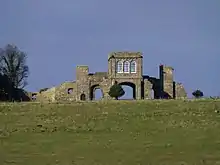Ratcheugh Observatory
Ratcheugh Observatory is a folly building constructed in the late 18th century on a prominent crag between Alnwick and Longhoughton in north Northumberland, England. Commissioned by Hugh Percy, 1st Duke of Northumberland, the Observatory is castellated in appearance, and incorporates a viewing tower with prospects of Alnwick and its castle, and of the North Sea coast at Boulmer.

Location
Ratcheugh Observatory is located on Ratcheugh Crag, a local 120-metre (390 ft) whinstone high-point above a foreground of fields at 85-metre (279 ft) or lower elevations, situated 2.2 miles (3.5 km) east-north-east of Alnwick and 1.2 miles (1.9 km) west-south-west of Longhoughton; 2.5 miles (4.0 km) inland from the coast at Boulmer, in north Northumberland.
Observatory
The Observatory at Ratcheugh is a screen-wall built at the crag edge, incorporated into which are a number of turrets or towers; and having towards its northern extent a square-plan viewing tower built on open hollow-chamfered arches. The tower has a single enclosed room, each wall having three large round-arched windows affording commanding views to the north-east, north-west, south-east and south-west. The structure is described by Historic England as a gazebo and eye-catcher in the Castellated Gothick style, and is constructed in rough-faced stone with ashlar dressings.[1]
The Observatory was designed by (or follows a design outline of) Robert Adam, and dates from 1754–1770.[2] It provides very fine views of Alnwick Castle, Hulne Park, Hulne Priory and other of the Duke's local possessions; a 360° panorama of the local area, farmland used for fox hunting and point-to-point horse racing; and distant views of Dunstanburgh and Warkworth Castles and the Farne Islands.
It is one of a number of prominent follies built on the skylines around Alnwick; other include the 1781 Brizlee Tower, another creation of the Duke;[3] Jenny's Lantern on the Bolton estate, and Crawley Tower on the Shawdon estate, all dating to the late 18th-century.[4][5]
The Observatory incorporates a small cottage, a later c.1850 addition. The Observatory is a Grade 1 listed building.[1]
References
- Historic England. "Ratcheugh Observatory (1154280)". National Heritage List for England.
- "Observatory at Ratcheugh Crag (Longhoughton)". Keys to the Past. Retrieved 6 January 2018.
- Historic England. "Brizlee Tower (1076985)". National Heritage List for England.
- Historic England. "Jenny's Lantern (1041960)". National Heritage List for England.
- Historic England. "Crawley Tower (1057698)". National Heritage List for England.